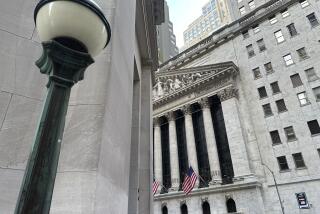Stocks Sink on Factory Report, Oil
Wall Street ran away from stocks again Friday and back toward the relative safety of Treasury bonds as a downbeat economic report compounded worries about a new high in oil prices.
The day’s bearish trend set the scene for the Federal Reserve’s meeting next week.
The Dow Jones industrial average slid 123.60 points, or 1.2%, to 10,297.84 after tumbling 166 points Thursday. It was the blue-chip index’s fifth straight decline and left it at the lowest level in six weeks.
Broader stock gauges also fell in heavy trading as near-term crude oil futures in New York rose 42 cents to $59.84 a barrel, a record high.
As on Thursday, the price of crude hit $60 during the session, but technical trading strategies triggered selling at that mark, some analysts said.
Traders said the market continued to focus on tighter U.S. oil inventories -- they have fallen for three weeks -- and the possibility of a disruption in supplies because of unexpected refinery shutdowns or other mishaps.
The stock market had been able to ignore rising oil prices for most of the last month. But the assault on the $60 level this week finally seemed to have an effect on investor sentiment, as it raised fresh concerns about the economy, some analysts said.
Those fears deepened Friday after the government said orders for durable goods, such as industrial equipment, slipped 0.2% in May, after excluding the volatile transportation sector. It was the third drop in four months.
Steve Hochberg, a market analyst at investment advisory firm Elliott Wave International in Gainesville, Ga., believes the economy is headed for recession by year’s end. He believes stock prices are beginning to reflect those expectations.
“All of the indicators we look at suggest we’re in a topping process” in the market, he said.
But the bearish view still is a minority on Wall Street. Many analysts said stocks were overdue for a pullback after their sharp run-up since late April.
“I think we’re coming into a buying opportunity,” said Marc Pado, U.S. market strategist for New York-based brokerage Cantor Fitzgerald.
Oil prices are sure to hit hard in some industries, such as transportation, Pado said. But he is optimistic that second-quarter earnings reports in technology, healthcare and other sectors could entice more investors into the market. “If we get a decent rally in tech this summer, that would help lift the overall indexes quite a bit,” he said.
The tech-dominated Nasdaq composite has risen faster than the Dow since late April and held up better than the blue-chip index this week. The Nasdaq index dropped 17.39 points, or 0.8%, to 2,053.27 on Friday and was off 1.8% this week. By contrast, the Dow’s 1.2% decline Friday left it down 3.1% for the week.
The Standard & Poor’s 500 index, which fell 9.16 points, or 0.8%, to 1,191.57 on Friday, lost 2.1% for the week.
For the day, falling stocks outnumbered winners by about 3 to 2 on the New York Stock Exchange and on Nasdaq as volume surged, in part because of trading related to the annual rebalancing of the popular Russell stock indexes.
As on Thursday, the market was led lower by industrial and transportation issues, whose fortunes are closely tied to economic swings. On the flip side, falling bond yields helped to lift some banks and other financial shares Friday.
Bond yields often decline as investors bet that the economy will weaken, on the assumption that interest rates in general will fall. The benchmark 10-year Treasury note yield eased to 3.92%, down from 3.95% on Thursday and nearing the 14-month low of 3.89% set June 1. The yield was 4.07% a week ago.
But many analysts aren’t convinced that the economy is headed for a significant downshifting. Goldman, Sachs & Co. economists told clients in a report Friday that, despite some downbeat data recently, there was no reason to expect a pronounced slowdown.
The markets’ focus now will turn to the Federal Reserve’s meeting Wednesday and Thursday. The Fed is widely expected to raise its benchmark short-term rate for the ninth time in the last year, from 3% to 3.25%.
Key, however, will be the Fed’s language in its statement -- and whether policymakers give any hint that they might be close to ending their credit-tightening campaign. That hope has helped to buoy stock and bond markets over the last two months, and investors could become more anxious about help from the Fed if oil shoots above $60 next week.
For now, however, analysts generally don’t expect the Fed to signal that it’s almost done.
More to Read
Inside the business of entertainment
The Wide Shot brings you news, analysis and insights on everything from streaming wars to production — and what it all means for the future.
You may occasionally receive promotional content from the Los Angeles Times.










